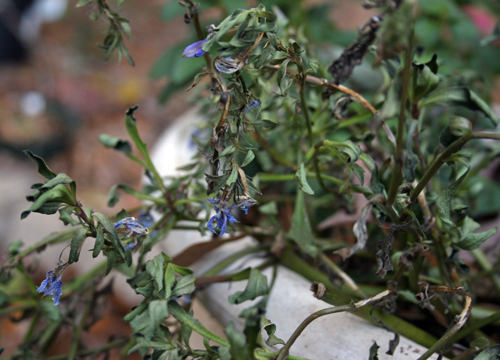Don’t let your time and money go to waste this spring. Protect your newly installed plants from freezing temperatures. Warm temperatures may fool you: Your plants aren’t safe until several days after the last frost date. Avoid cold snap damage by taking the proper precautions.
“It’s not the cold that kills the plant; it’s the ice freezing within the plant tissue. The tiny ice crystals literally shred the plant’s cell from the inside out,” said Paul Thomas, a University of Georgia Cooperative Extension horticulture specialist.
Check the weather regularly from February to April in order to plan ahead. While plants may be fine at 32 degrees, the more temperatures drop past 28 degrees, the more worried you should be about protecting your plants.
Woody plants such as trees or shrubs that were planted in the fall are hardy and dormant during the winter. Sugars concentrated in the stems of hardy plants prevent ice from forming. Once temperatures start warming up, however, hardiness is lost as water returns to the stems. New growth is especially vulnerable to frost.
Don’t plant vegetables and annuals until the danger of frost has passed. Thomas recommends checking frost-free dates for your area and planting five days after that date. The last frost is typically around March 10 in south Georgia and March 28 in north Georgia. In 2007, however, frosts occurred as late as early April.
Thomas recommends three different methods to protect freeze-vulnerable plants.
Cover the plants. The most common practice is to put blankets over fairly new shrubs (2- to 3-feet high). This will capture enough heat from the ground to minimize damage and keep the tissue from freezing solid.
Plastic works well to hold in the heat, but be sure to remove it by 8 a.m. Once the sun comes out, the temperature under the plastic quickly rises which can lead to cooked plants. If left on longer than a day, the plants will become susceptible to disease as moisture builds up on the plant tissue.
Matthew Chappell, a UGA Extension nursery specialist, suggests using nursery or tobacco cloth to cover plants. This can be found in rolls online or at seed stores. The cloth is lightweight and excellent for heat retention. It can be stored and reused again for up to 10 years.
“I’ve seen it work down to 12 degrees,” Chappell said.
Spray water on bushes and trees. The second method is especially useful for fruit trees, but it requires you to get up several times at night. Starting at midnight, spray water on bushes. As the water forms ice on the outside of the plant, a small amount of heat is made during ice formation, which keeps the inside of the plant slightly warmer.
Using fans to create wind is another suggestion. Wind makes it harder for frost to form. Thomas recommends this method for prize plants or shrubs in a limited area and says it is effective when used to reduce the amount of damage.
There much can be done to protect full-grown trees. They are typically mature and adaptive enough that they can take care of themselves and recover on their own.
Mulch your plants. The best protection is mulch, said Thomas. Put down 2 to 3 inches of pine straw when planting to reduce evaporation. Then, on cold nights, add 1.5 to 2 inches of pine straw on top of the plants to trap heat from the ground. He also suggests laying tall plants on the ground where it will be warmer. Cover these plants with pine straw as well. Afterward, carefully rake or hand-remove the pine straw off and save it to use again.
“That will prevent 90 percent of frost damage down to about 20 degrees,” Thomas says. “Considering that the average person might put $200 into their vegetable garden, for a little extra money in pine straw you can buy yourself some insurance.”
Thomas says wheat straw and leaves will also work. He cautions gardeners that leaves will become heavy when wet and could crush tender plants. If none of the above is available, four or five sheets of newspaper can also be substituted. To prevent the newspaper from blowing away, lightly moisten the paper with a hose.
Methods used for ornamental plants don’t work well for vegetables and seedlings.
Blankets do not work on seedlings because they are too heavy, especially when wet. Vegetable plants and flowers are herbaceous, so they need greater, yet lightweight, protection. Thomas also doesn’t recommend spraying vegetable plants with water because the ice can easily break the seedlings.









